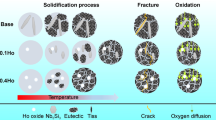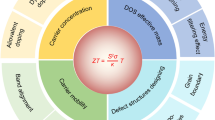Abstract
Doping n-type Bi2Te3-based alloys with Cu or Ag has been proven an effective way to improve their thermoelectric performance. However, the doping behavior is still not clear and the underneath mechanism needs more evidence to clarify. Herein, a study on the structure and transport properties of polycrystalline Ag-doped n-type Bi2Te2.7Se0.3 is performed. Raman and X-ray photoelectron spectroscopy analysis suggests that Ag ions are situated at the interstitial sites and transfer electrons to the neighbouring Te(Se). The newly established Ag-Te(Se) bonds lead to strengthened interlayer interaction and improved carrier mobility. Te(Se) vacancy, as an intrinsic feature in the polycrystalline Bi2Te2.7Se0.3 alloy, is alleviated due to the formation of Ag-Te(Se) bonds. The carrier concentration can be gradually adjusted to a lower level, at which largely improved room-temperature thermoelectric performance is yielded. As a result, the room-temperature dimensionless figure of merit ZT value and cooling performance of the optimal Ag-doped Bi2Te2.7Se0.3 are enhanced by nearly 60% and 75% as compared with those of the pristine Bi2Te2.7Se0.3.

摘要
采用Cu或Ag掺杂是提高n型Bi2Te3基合金热电性能的有效途径, 但Cu或Ag的掺杂行为仍不明确, 其背后的作用机理还需要进一步证实. 本文对Ag掺杂n型Bi2Te2.7Se0.3多晶热电材料的结构和输运性质进行了研究. 拉曼和X射线光电子能谱分析表明, Ag离子位于间隙位置, 并向邻近的Te(Se)转移电子. Ag与Te(Se)成键导致层间相互作用增强, 载流子迁移率升高. 由于Ag-Te(Se)成键, Bi2Te2.7Se0.3多晶的本征Te(Se)空位形成得到缓解, 进而逐渐将载流子浓度调节到较低水平, 因此Bi2Te2.7Se0.3的室温热电性能得到显著改善. 与单一Bi2Te2.7Se0.3相比, 最优Ag掺杂Bi2Te2.7Se0.3材料的室温热电优值ZT和制冷性能分别提高近60%和75%.
Similar content being viewed by others
References
Bell LE. Cooling, heating, generating power, and recovering waste heat with thermoelectric systems. Science, 2008, 321: 1457–1461
Yang L, Chen Z, Dargusch MS, et al. High performance thermoelectric materials: Progress and their applications. Adv Energy Mater, 2018, 8: 1701797
Shi X, Chen L, Uher C. Recent advances in high-performance bulk thermoelectric materials. Int Mater Rev, 2016, 61: 379–415
Snyder GJ, Toberer ES. Complex thermoelectric materials. Nat Mater, 2008, 7: 105–114
Wei Z, Wang C, Zhang J, et al. Precise regulation of carrier concentration in thermoelectric BiSbTe alloys via magnetic doping. ACS Appl Mater Interfaces, 2020, 12: 20653–20663
Luo Y, Yang J, Li G, et al. Enhancement of the thermoelectric performance of polycrystalline In4Se2.5 by copper intercalation and bromine substitution. Adv Energy Mater, 2014, 4: 1300599
Heremans JP, Wiendlocha B, Chamoire AM. Resonant levels in bulk thermoelectric semiconductors. Energy Environ Sci, 2012, 5: 5510–5530
Pei Y, Shi X, Lalonde A, et al. Convergence of electronic bands for high performance bulk thermoelectrics. Nature, 2011, 473: 66–69
Liu W, Tan X, Yin K, et al. Convergence of conduction bands as a means of enhancing thermoelectric performance of n-type Mg2Si1−xSnx solid solutions. Phys Rev Lett, 2012, 108: 166601
Zide JMO, Vashaee D, Bian ZX, et al. Demonstration of electron filtering to increase the Seebeck coefficient in In0.53Ga0.47As/In0.53Ga0.28-Al0.19As superlattices. Phys Rev B, 2006, 74: 205335
Li J, Tan Q, Li JF, et al. BiSbTe-based nanocomposites with high ZT: The effect of SiC nanodispersion on thermoelectric properties. Adv Funct Mater, 2013, 23: 4317–4323
Zhang Q, Ai X, Wang L, et al. Improved thermoelectric performance of silver nanoparticles-dispersed Bi2Te3 composites deriving from hierarchical two-phased heterostructure. Adv Funct Mater, 2015, 25: 966–976
Biswas K, He J, Blum ID, et al. High-performance bulk thermoelectrics with all-scale hierarchical architectures. Nature, 2012, 489: 414–418
Su X, Wei P, Li H, et al. Multi-scale microstructural thermoelectric materials: Transport behavior, non-equilibrium preparation, and applications. Adv Mater, 2017, 29: 1602013
Yang S, Ming H, Li D, et al. Enhanced phonon scattering and thermoelectric performance for N-type Bi2Te2.7Se0.3 through incorporation of conductive polyaniline particles. Chem Eng J, 2023, 455: 140923
Zhao W, Liu Z, Sun Z, et al. Superparamagnetic enhancement of thermoelectric performance. Nature, 2017, 549: 247–251
Ma S, Li C, Wei P, et al. High-pressure synthesis and excellent thermoelectric performance of Ni/BiTeSe magnetic nanocomposites. J Mater Chem A, 2020, 8: 4816–4826
Hu L, Zhu T, Liu X, et al. Point defect engineering of high-performance bismuth-telluride-based thermoelectric materials. Adv Funct Mater, 2014, 24: 5211–5218
Zhu H, Zhao JY, Xiao C. Improved thermoelectric performance in n-type BiTe facilitated by defect engineering. Rare Met, 2021, 40: 2829–2837
Ming H, Zhu C, Chen T, et al. Theoretical study of intrinsic and extrinsic point defects and their effects on thermoelectric properties of Cu2SnSe3. Inorg Chem, 2023, 62: 2607–2616
Cao YQ, Zhao XB, Zhu TJ, et al. Syntheses and thermoelectric properties of Bi2Te3/Sb2Te3 bulk nanocomposites with laminated nanostructure. Appl Phys Lett, 2008, 92: 143106
Liu Y, Zhang Y, Lim KH, et al. High thermoelectric performance in crystallographically textured n-type Bi2Te3−xSex produced from asymmetric colloidal nanocrystals. ACS Nano, 2018, 12: 7174–7184
Kim SI, Lee KH, Mun HA, et al. Dense dislocation arrays embedded in grain boundaries for high-performance bulk thermoelectrics. Science, 2015, 348: 109–114
Witting IT, Chasapis TC, Ricci F, et al. The thermoelectric properties of bismuth telluride. Adv Electron Mater, 2019, 5: 1800904
Wang H, Gurunathan R, Fu C, et al. Thermoelectric transport effects beyond single parabolic band and acoustic phonon scattering. Mater Adv, 2022, 3: 734–755
Li C, Ma S, Cui W, et al. Magnetoresistance-enhanced electro-thermal conversion performance. Mater Today Phys, 2021, 19: 100409
Li C, Ma S, Wei P, et al. Magnetism-induced huge enhancement of the room-temperature thermoelectric and cooling performance of p-type BiSbTe alloys. Energy Environ Sci, 2020, 13: 535–544
Liu WS, Zhang Q, Lan Y, et al. Thermoelectric property studies on Cu-doped n-type CuxBi2Te2.7Se0.3 nanocomposites. Adv Energy Mater, 2011, 1: 577–587
Li S, Liu X, Liu Y, et al. Optimized hetero-interfaces by tuning 2D SnS2 thickness in Bi2Te2.7Se0.3/SnS2 nanocomposites to enhance thermoelectric performance. Nano Energy, 2017, 39: 297–305
Pan Y, Wei TR, Cao Q, et al. Mechanically enhanced p- and n-type Bi2Te3-based thermoelectric materials reprocessed from commercial ingots by ball milling and spark plasma sintering. Mater Sci Eng-B, 2015, 197: 75–81
Zhang C, Fan XA, Hu J, et al. Changing the band gaps by controlling the distribution of initial particle size to improve the power factor of n-type Bi2Te3 based polycrystalline bulks. Adv Eng Mater, 2017, 19: 1600696
Yan X, Poudel B, Ma Y, et al. Experimental studies on anisotropic thermoelectric properties and structures of n-type Bi2Te2.7Se0.3. Nano Lett, 2010, 10: 3373–3378
Chen J, Zhou X, Uher C, et al. Structural modifications and nonmonotonic carrier concentration in Bi2Se0.3Te2.7 by reversible electrochemical lithium reactions. Acta Mater, 2013, 61: 1508–1517
Wu Y, Zhai R, Zhu T, et al. Enhancing room temperature thermoelectric performance of n-type polycrystalline bismuth-telluride-based alloys via Ag doping and hot deformation. Mater Today Phys, 2017, 2: 62–68
Wang S, Li H, Lu R, et al. Metal nanoparticle decorated n-type Bi2Te3-based materials with enhanced thermoelectric performances. Nanotechnology, 2013, 24: 285702
Chen C, Wang T, Yu Z, et al. Modulation doping enables ultrahigh power factor and thermoelectric ZT in n-type Bi2Te2.7Se0.3. Adv Sci, 2022, 9: 2201353
Hu LP, Zhu TJ, Yue XQ, et al. Enhanced figure of merit in antimony telluride thermoelectric materials by In-Ag co-alloying for mid-temperature power generation. Acta Mater, 2015, 85: 270–278
Yu HJ, Jeong M, Lim YS, et al. Effects of Cu addition on band gap energy, density of state effective mass and charge transport properties in Bi2Te3 composites. RSC Adv, 2014, 4: 43811–43814
Jeong M, Tak JY, Lee S, et al. Effects of Cu incorporation as an acceptor on the thermoelectric transport properties of Cu Bi2Te2.7Se0.3 compounds. J Alloys Compd, 2017, 696: 213–219
Chen X, Li J, Shi Q, et al. Isotropic thermoelectric performance of layer-structured n-type Bi2Te2.7Se0.3 by Cu doping. ACS Appl Mater Interfaces, 2021, 13: 58781–58788
Wu HJ, Yen WT. High thermoelectric performance in Cu-doped Bi2Te3 with carrier-type transition. Acta Mater, 2018, 157: 33–41
Yen WT, Huang HC, Wang KK, et al. Nano-precipitation and carrier optimization synergistically yielding high-performance n-type Bi2Te3 thermoelectrics. Mater Today Phys, 2021, 19: 100416
Kresse G, Furthmüller J. Efficiency of ab-Initio total energy calculations for metals and semiconductors using a plane-wave basis set. Comput Mater Sci, 1996, 6: 15–50
Kresse G, Furthmüller J. Efficient iterative schemes for ab initio total-energy calculations using a plane-wave basis set. Phys Rev B, 1996, 54: 11169–11186
Perdew JP, Burke K, Ernzerhof M. Generalized gradient approximation made simple. Phys Rev Lett, 1996, 77: 3865–3868
Kresse G, Joubert D. From ultrasoft pseudopotentials to the projector augmented-wave method. Phys Rev B, 1999, 59: 1758–1775
Blöchl PE. Projector augmented-wave method. Phys Rev B, 1994, 50: 17953–17979
Kim C, Lopez DH, Kim DH, et al. Dual defect system of tellurium antisites and silver interstitials in off-stoichiometric Bi2(Te,Se)3+y causing enhanced thermoelectric performance. J Mater Chem A, 2019, 7: 791–800
Richter W, Becker CR. A Raman and far-infrared investigation of phonons in the rhombohedral V2–VI3 compounds Bi2Te3, Bi2Se3, Sb2Te3 and Bi2(Te1−xSex)3 (0 < x < 1), (Bi1−ySby)2Te3 (0 < y < 1). Phys Stat Sol (b), 1977, 84: 619–628
Goncalves LM, Couto C, Alpuim P, et al. Optimization of thermoelectric properties on Bi2Te3 thin films deposited by thermal co-evaporation. Thin Solid Films, 2010, 518: 2816–2821
Meena DK, Bose RSC, Vinoth S, et al. Impact of melt solidification rate on structural and thermoelectric properties of n-type Bi2Te3 alloy. Appl Phys A, 2022, 128: 528
Shahil KMF, Hossain MZ, Goyal V, et al. Micro-Raman spectroscopy of mechanically exfoliated few-quintuple layers of Bi2Te3, Bi2Se3, and Sb2Te3 materials. J Appl Phys, 2012, 111: 054305
Lu MP, Liao CN, Huang JY, et al. Thermoelectric properties of Ag-doped Bi2(Se,Te)3 compounds: Dual electronic nature of Ag-related lattice defects. Inorg Chem, 2015, 54: 7438–7444
Acknowledgements
This work was supported by the National Key R&D Program of China (2019YFA0704903), the National Natural Science Foundation of China (11834012, 52172232, 52130203, and 91963122), and Foshan Xianhu Laboratory of the Advanced Energy Science and Technology Guangdong Laboratory (XHT2020-004).
Author information
Authors and Affiliations
Contributions
Zhao W, Wei P, and Zhang Q supervised the overall project. Li L and Yang M carried out the experiments and property measurements. Li L, Wei P, and Zhao W wrote the manuscript. Zhu W and Nie X performed the material characterization. All authors analyzed the results.
Corresponding authors
Ethics declarations
The authors declare that they have no conflict of interest.
Additional information
Supplementary information
Supporting data are available in the online version of the paper.
Long Li is currently studying for his MS degree at Wuhan University of Technology (WUT). He obtained a Bachelor’s degree in engineering from Xi’an Technology University in 2020. His research focuses on thermal electromagnetic materials and devices.
Ping Wei is currently working at the State Key Laboratory of Advanced Technology for Materials Synthesis and Processing (SKLATMSP), WUT as a professor. He received his BS degree at Shandong University in 2005, MS degree in 2009 and PhD in 2012 at WUT. His research focuses on the performance optimization and structural characterization of thermoelectric and magnetic materials.
Wenyu Zhao received his MS degree in 1996 at China University of Geosciences and PhD degree in 2004 at WUT. He has been working at SKLATMSP of WUT as a full professor since 2008. His research interests include thermoelectric materials, magnetic thermoelectric materials, magnetic ferrite materials, novel structure thermoelectric devices, and thermoelectric application technology.
Qingjie Zhang received his MS degree in 1984 and PhD degree in 1990 from Huazhong University of Science and Technology. He is working at SKLATMSP of WUT as a full professor and at Xianhu Laboratory as the director. He is an academician of the Chinese Academy of Sciences. His research focuses on the thermoelectric materials and the related application technology.
Supplementary Materials
40843_2023_2485_MOESM1_ESM.pdf
Strengthened interlayer interaction and improved room-temperature thermoelectric performance of Ag doped n-type Bi2Te2.7Se0.3
Rights and permissions
About this article
Cite this article
Li, L., Wei, P., Yang, M. et al. Strengthened interlayer interaction and improved room-temperature thermoelectric performance of Ag-doped n-type Bi2Te2.7Se0.3. Sci. China Mater. 66, 3651–3658 (2023). https://doi.org/10.1007/s40843-023-2485-5
Received:
Accepted:
Published:
Issue Date:
DOI: https://doi.org/10.1007/s40843-023-2485-5




